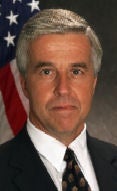The revolving door at the federal government’s highest cyber security level
took another turn Tuesday with the resignation of Robert Liscouski, the
Department of Homeland Security’s assistant secretary for infrastructure
protection.
The resignation comes just four months after Amit Yoran
resigned from his post
as director of the DHS’ National Cyber Security Division
(NCSD). Yoran was reportedly frustrated over a lack of focus on computer
security issues within the administration.
 |
| Robert P. Liscouski |
| Source: DHS.gov |
DHS Secretary Tom Ridge appointed Liscouski, the former director of information assurance for Coca-Cola,
to his position in March 2003.
His responsibilities included identifying critical infrastructures and
proposing protective measures. Liscouski issued no statement on his
resignation and was unavailable for comment Wednesday afternoon.
Ridge issued a statement thanking Liscouski for his service and said he
“provided a solid foundation for protecting our nation’s critical
infrastructure.”
Liscouski’s resignation is the latest in a series of high-profile turnovers
within the Bush administration’s cyber security personnel. In the aftermath of
the 9/11 terrorist attacks, Bush dismantled a special cyber security board
that reported directly to the White House and transferred the board’s duties
and responsibilities to the DHS.
The Bush administration also reviewed the nation’s critical infrastructure
and decided it could not improve security alone, considering 85 percent is
owned by the private sector. In February 2003, the Bush administration
officially released its National
Strategy to Secure Cyberspace, which calls for a voluntary partnership
between the public and private sectors to share security intelligence,
reduce vulnerabilities and deter malicious entities.
Critics have attacked the plan for being too loosely based and too dependent on
private enterprise without enough checks and balances. IT officials in the private sector, in particular, have called for a greater emphasis on cyber security.
Richard Clarke, the White House’s director of the board, refused to head the
new organization created at the DHS, saying there would be too many
bureaucratic layers between him and Ridge. Howard Schmidt, Clarke’s deputy
on the White House board, resigned in May 2003 to become the chief
information security officer for eBay.
Clarke later testified before Congress that the DHS was placing
infrastructure concerns over security issues and that the Bush
administration’s IT security initiatives were suffering from a lack of
leadership and resources. (However, in a 2002 interview that was leaked by Fox News, Clarke also praised the Bush administration’s homeland security efforts.)
Ridge appointed Yoran as director of the NCSD in September 2003. Yoran
was a co-founder of Riptech, an Alexandria, Va.-based firm that focused on
government cyber security. In July 2002, Symantec bought Riptech for $145
million, and Yoran stayed on as vice president for managed security
services.
The NCSD has an $80 million budget and 60 employees. Its primary
responsibilities include conducting cyberspace analysis, issuing alerts and
warnings, improving information sharing, responding to major incidents and
aiding in national-level recovery efforts. With Yoran at the helm, the NCSD
began a program that allowed subscribers to receive e-mails about virus
outbreaks and proper responses to the attacks.


